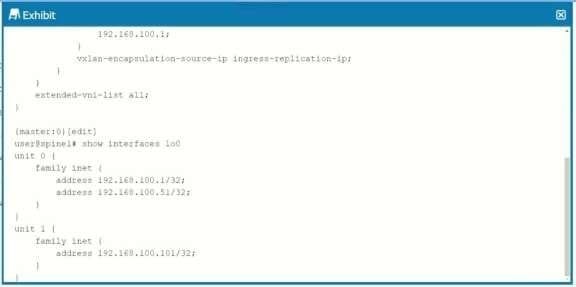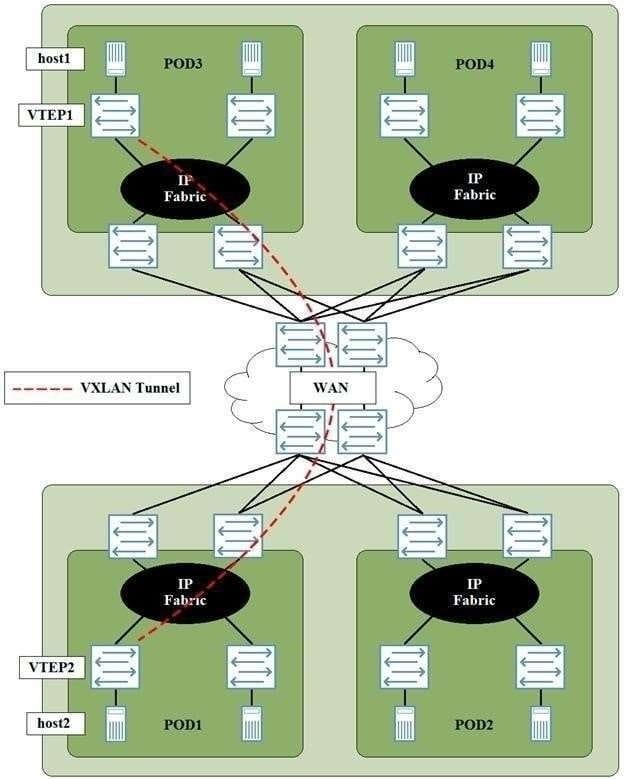Exam Details
Exam Code
:JN0-682Exam Name
:Data Center, Professional (JNCIP-DC)Certification
:Juniper CertificationsVendor
:JuniperTotal Questions
:130 Q&AsLast Updated
:Jul 29, 2025
Juniper Juniper Certifications JN0-682 Questions & Answers
-
Question 21:
Which protocol replicates forwarding information between MC-LAG peers?
A. VCCP
B. ICCP
C. VRRP
D. LLDP
-
Question 22:
What are three advantages of using MPLS for data center interconnects? (Choose two.)
A. Dedicated MPLS backbones for Layer 1 and Layer 3 DCIs
B. Any to any connectivity
C. Dedicated connections between customer sites
D. Sub 50 ms failover times
E. Traffic engineering
-
Question 23:
A customer wants to connect two data centers on different subnets using EVPN. What are two implications of using different IP subnets at each site? (Choose two.)
A. Using different IP subnets at each site allows Layer 3 gateways to exchange only type-3 routes.
B. MAC addresses will need to be advertised between the data centers.
C. MAC addresses will not need to be advertised between the data centers.
D. Using different IP subnets at each site allows Layer 3 gateways to exchange only type-5 routes.
-
Question 24:
You manage a data center with a 5-stage EVPN-VXLAN IP fabric. You notice that there are suboptimal paths used between the leaf and spine as well as the spine and super spine. What is one way to solve this issue?
A. Configure the super spine and spine layers to all use the same ASN.
B. Configure the spine layer for EBGP and the leaf layer for IBGP
C. Configure the spine layer so that all spines in a POD share the same ASN.
D. Configure the leaf layer so that all leaf devices share the same ASN.
-
Question 25:
You want to ensure high availability of the Junos devices in your data center. In this scenario, which three features would accomplish this task? (Choose three.)
A. Multiple Spanning Tree Protocol
B. Virtual Router Redundancy protocol
C. graceful Routing Engine switchover
D. Dual Routing Engineers
E. Virtual private LAN service
-
Question 26:
Which two characteristics would you consider when selecting spine devices in an IP fabric? (Choose two.)
A. scaling limitations
B. spanning tree limitations
C. port density
D. data center location
-
Question 27:
The configuration shown in the exhibit is intended to set up assisted replication but will not commit. Which action will create a valid configuration in this situation?

A. Change the 10.0 address to 192.168.100.1 primary.
B. Change the replicator inet address to 192.168.100.101.
C. Delete replicator inet 192.168.100.1.
D. Change the replicator inet address to 192.168.100. 51.
-
Question 28:
A VXLAN has been created between devices leaf1 and Ieaf3.

Referring to the exhibit, which statement is true?
A. Traffic sent from host1 to host2 will be dropped on Ieaf3.
B. Traffic sent from host1 to host2 will be tagged with VLAN ID 100 when exiting Ieaf3.
C. Traffic sent from host1 to host2 will be tagged with VLAN ID 200 when exiting Ieaf3.
D. Traffic sent from host1 to host2 will be dropped on leaf1.
-
Question 29:
Referring to the exhibit, DC1 and DC2 have a DCI across a service provider WAN connection. Host1 in DC1 must have Layer 2 connectivity to host2 in DC2. A VXLAN tunnel must be created between VTEP1 and VTEP2.

In this scenario, which statement is true?
A. A route to the loopback address on VTEP must be present on VTEP1.
B. VTEP and VTEP2 must peer using IBGP.
C. VXLAN Layer 3 gateway must be provisioned at the Super Spine layer.
D. The service provider WAN connection be an MPL5-based WAN connection.
-
Question 30:
You have deployed two data centers that require a Layer 2 stretch between host1 and host2.

Referring to the exhibit, what does a Layer 2 stretch require?
A. A VPLS WAN connection data centers
B. A VXLAN tunnel originating on VTEP1 to VTEP2
C. A VXLAN tunnel originating on the super Spine Layer in DC1 to the Super Spine Layer in DC2
D. A VXLAN tunnel originating on the Spine Layer in DC1 to the Spine Layer in DC2.
Related Exams:
JN0-102
Internet Associate, Junos(JNCIA-Junos)JN0-104
Junos, Associate (JNCIA-Junos)JN0-105
Junos, Associate (JNCIA-Junos)JN0-1101
Juniper Networks Certified Design Associate (JNCDA)JN0-1103
Design, Associate (JNCIA-Design)JN0-130
Juniper networks Certified internet specialist.e(jncis-e)JN0-1301
Data Center Design, Specialist (JNCDS-DC)JN0-1302
Data Center Design Specialist (JNCDS-DC)JN0-1331
Security Design, Specialist (JNCDS-SEC)JN0-1332
Security Design, Specialist (JNCDS-SEC)
Tips on How to Prepare for the Exams
Nowadays, the certification exams become more and more important and required by more and more enterprises when applying for a job. But how to prepare for the exam effectively? How to prepare for the exam in a short time with less efforts? How to get a ideal result and how to find the most reliable resources? Here on Vcedump.com, you will find all the answers. Vcedump.com provide not only Juniper exam questions, answers and explanations but also complete assistance on your exam preparation and certification application. If you are confused on your JN0-682 exam preparations and Juniper certification application, do not hesitate to visit our Vcedump.com to find your solutions here.